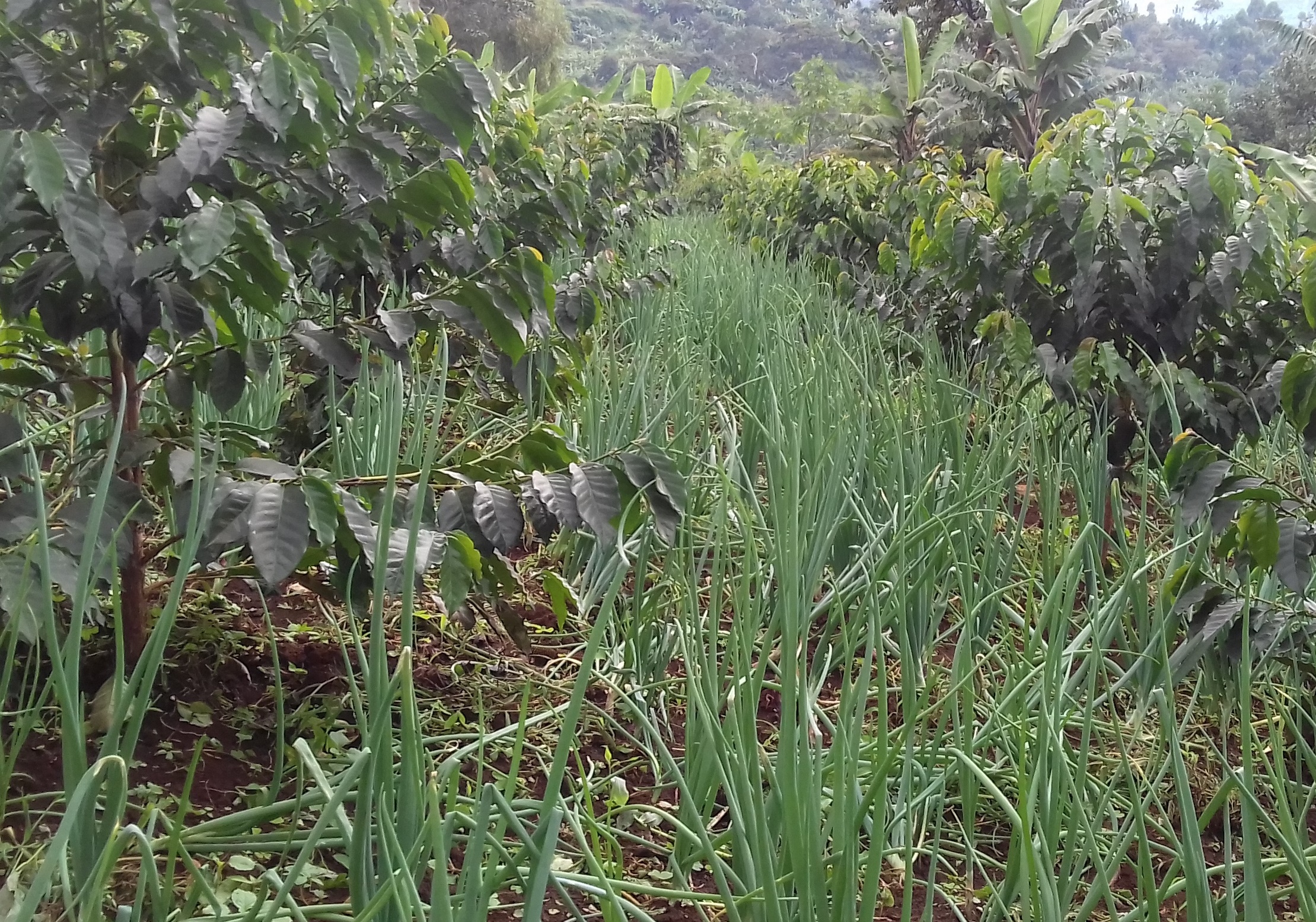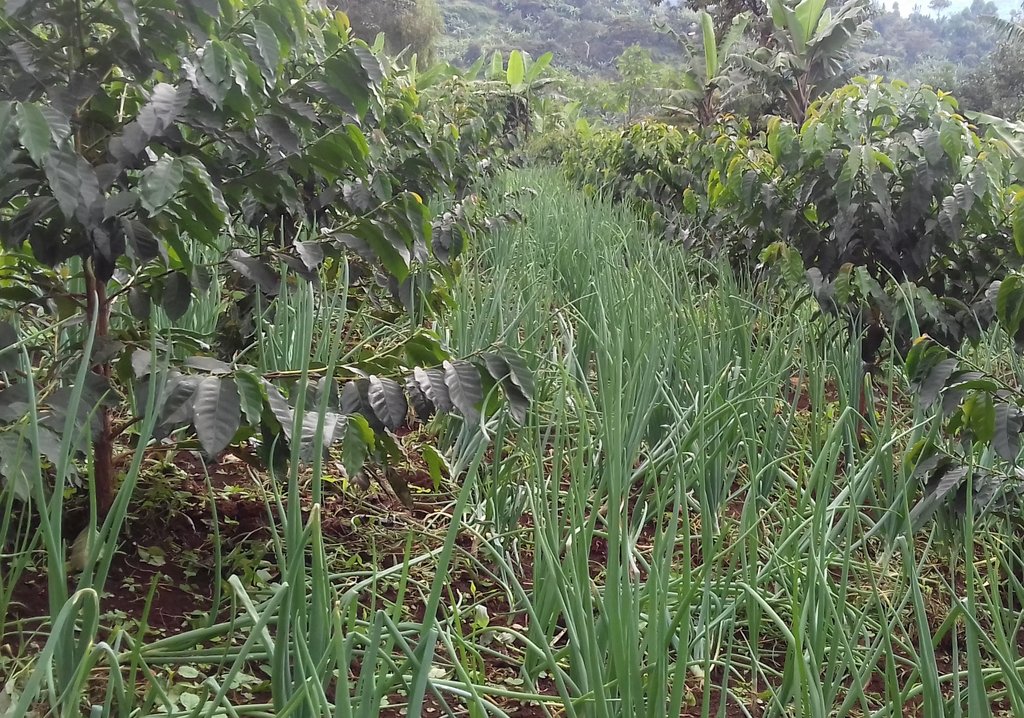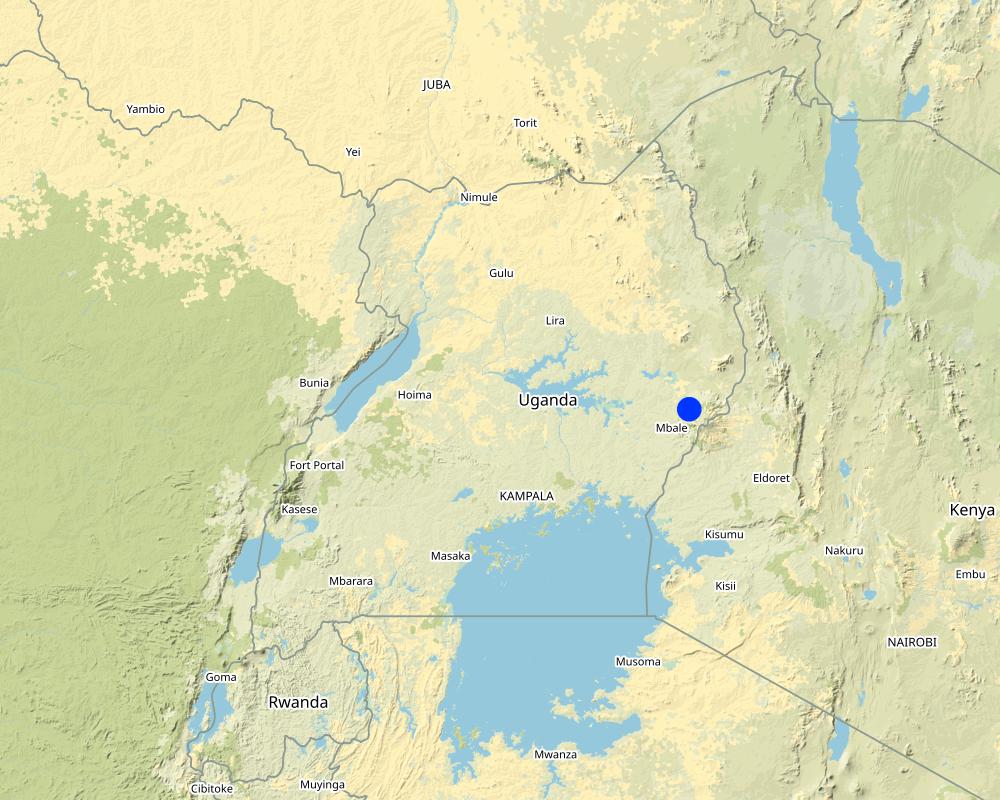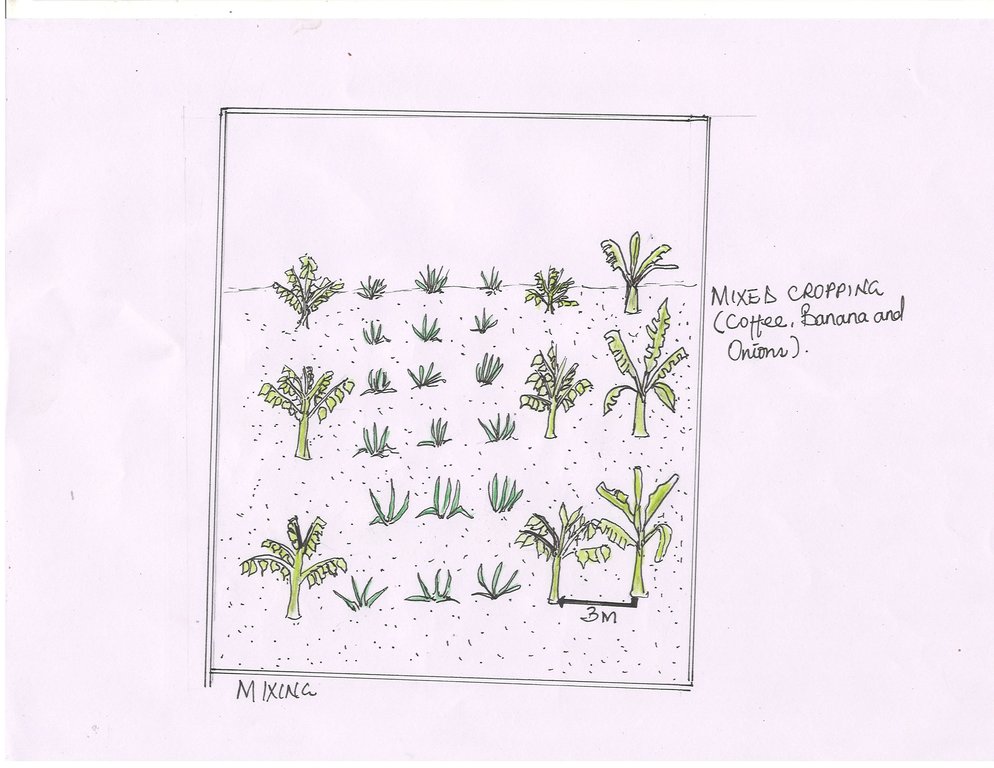Mixed Cropping of Coffee, Banana and Onions for Increased Production, Food Security and Household Income [អ៊ូហ្គង់ដា]
- ការបង្កើត៖
- បច្ចុប្បន្នភាព
- អ្នកចងក្រង៖ Babirye Irene
- អ្នកកែសម្រួល៖ Kamugisha Rick Nelson
- អ្នកត្រួតពិនិត្យច្រើនទៀត៖ Nicole Harari, Udo Höggel
Okulima emwanyi, matooke n'obutugulu
technologies_3378 - អ៊ូហ្គង់ដា
ពិនិត្យមើលគ្រប់ផ្នែក
ពង្រីកមើលទាំងអស់ បង្រួមទាំងអស់1. ព័ត៌មានទូទៅ
1.2 ព័ត៌មានលម្អិតពីបុគ្គលសំខាន់ៗ និងស្ថាប័នដែលចូលរួមក្នុងការវាយតម្លៃ និងចងក្រងឯកសារនៃបច្ចេកទេស
បុគ្គលសំខាន់ម្នាក់ (ច្រើននាក់)
អ្នកប្រើប្រាស់ដី:
Wogudunya Wilson
+256702390798
Duwabana Farmer's Association
Kikameli Village, Kibando town, Bulambuli District
អ៊ូហ្គង់ដា
ឈ្មោះគម្រោងដែលបានចងក្រងឯកសារ/ វាយតម្លៃលើបច្ចេកទេស (បើទាក់ទង)
Scaling-up SLM practices by smallholder farmers (IFAD)ឈ្មោះអង្គភាពមួយ (ច្រើន) ដែលបានចងក្រងឯកសារ/ វាយតម្លៃបច្ចេកទេស (បើទាក់ទង)
National Agricultural Research Organisation (NARO) - អ៊ូហ្គង់ដា1.3 លក្ខខណ្ឌទាក់ទងទៅនឹងការប្រើប្រាស់ទិន្នន័យដែលបានចងក្រងតាមរយៈ វ៉ូខេត
តើពេលណាដែលទិន្នន័យបានចងក្រង (នៅទីវាល)?
19/10/2017
អ្នកចងក្រង និង(បុគ្គលសំខាន់ៗ)យល់ព្រមទទួលយកនូវលក្ខខណ្ឌនានាទាក់ទងទៅនឹងការប្រើប្រាស់ទិន្នន័យដែលបានចងក្រងតាមរយៈវ៉ូខេត:
បាទ/ចា៎
1.4 សេចក្តីប្រកាសស្តីពីចីរភាពនៃការពណ៌នាពីបច្ចេកទេស
តើបច្ចេកទេសដែលបានពណ៌នានេះមានបញ្ហាដែលផ្តោតលើការធ្លាក់ចុះគុណភាពដី, បើដូច្នេះវាមិនអាចត្រូវបានប្រកាសថាជាបច្ចេកទេសនៃការគ្រប់គ្រងប្រកបដោយចីរភាពទេ?
ទេ
2. ការពណ៌នាពីបច្ចេកទេស SLM
2.1 ការពណ៌នាដោយសង្ខេបពីបច្ចេកទេស
និយមន័យបច្ចេកទេស:
Mixed Cropping of coffee (Coffea Canephora) , banana (Musa) and onions (Allium cepa) is a sustainable traditional land management practice that involves the growing of two or more crops (coffee, banana and onions) at the same time on the same field by smallholder farmers for increased production, food security and household income.
2.2 ការពណ៌នាលម្អិតពីបច្ចេកទេស
ការពណ៌នា:
Coffee, banana and onions mixed cropping; is a traditional practice promoted by smallholder farmers in Uganda established in Bulambuli district, Kibande Sub-county, Kimameli village. The area experiences two growing seasons per year; April up to July and September up to December with rainfall ranging from 1, 0001 mm-1,500 mm on 3.4 ha of land located on a gentle sloping area. The aim of this technology is increasing food production, household income , soil fertility improvement , maximizing crop production in a context of population pressure and declining arable land size.
Banana (Musa) and coffee (Coffea Canephora) plantations were established in 2016 followed by onions (Allium cepa) later in August 2017 with Coffee (Coffea robusta) planted at a spacing of 10 feet apart from Coffee to avoid competition for soil nutrients. Using hoes, pangas, coffee and onion seedlings, banana suckers were inter cropped at the ratio of 1 banana to 4 coffee trees on a 3.4 ha. Coffee trees were pruned initially to create room for the banana plants during their establishment. When coffee and banana were planted simultaneously in the field, onions were grown in between them for one year to provide some income before the banana and coffee were ready for harvesting. To establish such a technology the farmer accomplished the following activities: 1.preparing the garden (labor time: four days with three people), 2.Manure application where compost manure was mixed with soil (labor time: one day by three people), 3. Planting (three days by three people for all the crops), 4.Pruning where relevant adjustments were done regularly to the system (e.g. mature coffee trees are pruned to create space for onions to grow is done every three days by one person), and 5. Weeding since inter cropping requires weeding which should be done manually and not with a hoe because it may accidentally damage the roots of the coffee plant.
What is liked about this technology is that its very good according to the farmer’s experience. It is applied on a small piece of land and it incorporates many crops which helps to improve soil fertility, increase crop yield which generates more income and food for consumption. There is also good utilization of labor as a farmer will work on all the crops simultaneously. The farmer testified that bananas provide shade, mulch, nutrients and moisture to young coffee trees. These beneficial effects may particularly be relevant to increase the resilience of the coffee production systems when temperature increases and rainfall becomes more erratic due to climate change. On the other hand coffee being a perennial crop, it requires high levels of initial investment (i.e. labor and capital) with a 10 - 15 years time horizon. The extended time period before realization of economic benefits usually discourages land users from adopting coffee inter cropping with other crops. Also, coffee creates shade which does not favor the growth of maize, beans and tomatoes in the same land, hence there’s competition between the crops for nutrients.
2.3 រូបភាពនៃបច្ចេកទេស
2.4 វីដេអូនៃបច្ចេកទេស
ការពណ៌នាសង្ខេប:
The video showing coffee and banana inter-cropped with onions
កាលបរិច្ឆេទ:
18/10/2017
ទីតាំង:
Kikameli village, Bulambuli District.
ឈ្មោះអ្នកថតវីឌីអូ:
Irene Babirye
2.5 ប្រទេស/តំបន់/ទីតាំងកន្លែង ដែលបច្ចេកទេសត្រូវបានអនុវត្ត និងបានគ្រប់ដណ្តប់ដោយការវាយតម្លៃនេះ
ប្រទេស:
អ៊ូហ្គង់ដា
តំបន់/រដ្ឋ/ខេត្ត:
Eastern Region
បញ្ជាក់បន្ថែមពីលក្ខណៈនៃទីតាំង:
Kikameli village, Kibande sub-county, Bulambuli District
Map
×2.6 កាលបរិច្ឆេទនៃការអនុវត្ត
បង្ហាញឆ្នាំនៃការចុះអនុវត្ត:
2017
2.7 ការណែនាំពីបច្ចេកទេស
សូមបញ្ជាក់តើបច្ចេកទេសត្រូវបានណែនាំឱ្យអនុវត្តដោយរបៀបណា:
- តាមរយៈការបង្កើតថ្មីរបស់អ្នកប្រើប្រាស់ដី
- តាមរយៈគម្រោង / អន្តរាគមន៍ពីខាងក្រៅ
មតិយោបល់ (ប្រភេទនៃគម្រោង ។ល។):
Land user knew about the technology but he was motivated through projects
3. ចំណាត់ថ្នាក់នៃបច្ចេកទេស SLM
3.1 គោលបំណងចម្បង (១ ឬច្រើន) នៃបច្ចេកទេសនេះ
- ធ្វើឱ្យប្រសើរឡើងនូវផលិតកម្ម
- កាត់បន្ថយ, បង្ការ, ស្តារឡើងវិញនូវការធ្លាក់ចុះគុណភាពដី
- អភិរក្សប្រព័ន្ធអេកូឡូស៊ី
- បន្ស៊ាំទៅនឹងការប្រែប្រួលអាកាសធាតុ/គ្រោះមហន្តរាយ និងផលប៉ះពាល់របស់វា
- បង្កើតផលប្រយោជន៍សេដ្ឋកិច្ច
3.2 ប្រភេទដីប្រើប្រាស់មួយប្រភេទ (ច្រើនប្រភេទ) ដែលបានអនុវត្តបច្ចេកទេស

ដីដាំដំណាំ
- ដំណាំប្រចាំឆ្នាំ
- ដំណាំរយៈពេលវែង (មិនមែនឈើ)
ដំណាំចម្បង (ដំណាំកសិ-ឧស្សាហកម្ម និងដំណាំស្បៀង) :
Coffee, Banana and Onions
3.3 ព័ត៌មានបន្ថែមអំពីអ្នកប្រើប្រាស់ដី
ការផ្គត់ផ្គង់ទឹកនៅកន្លែងអនុវត្តបច្ចេកទេស:
- ទឹកភ្លៀង
ចំនួនសារដែលដាំដំណាំក្នុងមួយឆ្នាំ:
- 2
សូមបញ្ជាក់:
March to May and September to December
3.4 ក្រុម SLM ដែលបច្ចេកទេសស្ថិតនៅក្នុង
- ការគ្រប់គ្រងជីជាតិដីតាមបែបចម្រុះ
- បញ្ចូលការគ្រប់គ្រងសត្វល្អិត និងជំងឺតាមបែបចម្រុះ (រួមទាំង កសិកម្មសរីរាង្គ)
- គេហសួន
3.5 ការសាយភាយនៃបច្ចេកទេស
បញ្ជាក់ពីការសាយភាយនៃបច្ចេកទេស:
- ត្រូវបានផ្សព្វផ្សាយត្រឹមតំបន់មួយ
ប្រសិនបើបច្ចេកទេសត្រូវបានសាយភាយពាសពេញតំបន់ណាមួយ សូមកំណត់ទំហំផ្ទៃដីអនុវត្តន៍:
- < 0.1 គម2 (10 ហិកតា)
មតិយោបល់:
The technology is practiced on 3.5 hectares.
3.6 វិធានការ SLM ដែលបញ្ចូលនូវបច្ចេកទេស

វិធានការក្សេត្រសាស្ត្រ
- A1: ដំណាំ/គម្របដី
- A2: សារធាតុសរីរាង្គ/ជីជាតិដី

វិធានការគ្រប់គ្រង
- M4: ការផ្លាស់ប្តូរចម្បងៗក្នុងការកំណត់ ពេលអនុវត្តសកម្មភាព
- M6: ការគ្រប់គ្រងសំណល់ (កែឆ្នៃទ្បើងវិញ ប្រើប្រាស់ឡើងវិញ ឬបន្ថយការប្រើប្រាស់)
3.7 កំណត់ប្រភេទនៃការធ្លាក់ចុះគុណភាពដីសំខាន់ៗដែលបច្ចេកទេសនេះបានដោះស្រាយ

ការហូរច្រោះដីដោយសារទឹក
- Wt: ការបាត់ដីស្រទាប់លើដោយការហូរច្រោះ

ការបាត់ដីដោយសារខ្យល់
- Et: ការបាត់បង់ដីស្រទាប់លើ

ការធ្លាក់ចុះជីវសាស្ត្រនៃដី
- Bq: ការថយចុះនូវជីវម៉ាស/ បរិមាណ
- Bp: ការកើនឡើងនូវសត្វល្អិត ឬជំងឺ បាត់បង់នូវសត្វមានប្រយោជន៍
3.8 ការពារ កាត់បន្ថយ ឬស្តារឡើងវិញនៃការធ្លាក់ចុះគុណភាពដី
បញ្ជាក់ពីគោលដៅរបស់បច្ចេកទេស ដែលផ្តោតទៅការធ្លាក់ចុះគុណភាពដី:
- ការការពារការធ្លាក់ចុះគុណភាពដី
- ការកាត់បន្ថយការធ្លាក់ចុះគុណភាពដី
មតិយោបល់:
The technology prevents and reduces land degradation through reduced soil erosion and soil exposure and increase soil cover.
4. បច្ចេកទេសជាក់លាក់ សកម្មភាពអនុវត្ត ធាតុចូល និងថ្លៃដើម
4.1 គំនូសបច្ចេកទេសនៃបច្ចេកទេសនេះ
4.2 លក្ខណៈពិសេសនៃបច្ចេកទេស/ ពណ៌នាពីគំនូរបច្ចេកទេស
Banana and coffee plantations were established in 2016 and onions added later in August 2017. This practice is carried out on 3.4 ha.
Coffee is the major crop planted with spacing of 3m x 3m, then banana was intercropped at the ratio of 1 banana to 4 coffee trees.
The coffee trees were pruned initially to create room for the banana plants during their establishment. When coffee and banana were planted simultaneously in the field, onions were grown in between them for one year to provide some income before the banana and coffee were ready for harvesting.
The activities and labor demands include:
Digging holes and preparing the garden (labour time: 4 days by 3 people).
Manure application where compost manure was mixed with soil (labour time: 1 day by 3 people).
Planting (3 days by 3 people for all the crops).
Pruning where relevant adjustments are done regularly to the system (e.g. mature coffee trees are pruned to create space for onions to grow is done every three days by one person).
Labor costs are 5000 Uganda shillings per person a day.
Coffee takes three years for the first harvest to happen, onions take four months to grow - here harvesting is continuous.
4.3 ព័ត៌មានទូទៅដែលពាក់ព័ន្ធនឹងការគណនាធាតុចូល និងថ្លៃដើម
កំណត់របៀបនៃការគណនាថ្លៃដើម និងធាតុចូល:
- ក្នុងតំបន់អនុវត្តបច្ចេកទេស
កំណត់ទំហំ និងឯកត្តាផ្ទៃដី:
3.4 hectares
កំណត់រូបិយប័ណ្ណសម្រាប់ថ្លៃដើម:
- ដុល្លារអាមេរិក
កំណត់អត្រាប្តូរប្រាក់ពីដុល្លាទៅរូបិយប័ណ្ណតំបន់ (បើទាក់ទង)៖ 1 ដុល្លារ =:
3600,0
កំណត់ថ្លៃឈ្នួលជាមធ្យមនៃការជួលកម្លាំងពលកម្មក្នុងមួយថ្ងៃ:
1.39
4.4 សកម្មភាពបង្កើត
| សកម្មភាព | ប្រភេទវិធានការ | ពេលវេលា | |
|---|---|---|---|
| 1. | Digging/ Garden preparation | ក្សេត្រសាស្ត្រ | 1 week before the rains |
| 2. | Fertilizer Application | ក្សេត្រសាស្ត្រ | 2 days |
| 3. | Planting | ក្សេត្រសាស្ត្រ | Before onset of rains |
| 4. | Spraying | ក្សេត្រសាស្ត្រ | Every after two weeks |
| 5. | Prunning | ក្សេត្រសាស្ត្រ | monthly |
| 6. | Harvesting | ក្សេត្រសាស្ត្រ | Seasonal |
មតិយោបល់:
Harvesting onions is done every after three months.
4.5 ថ្លៃដើម និងធាតុចូលដែលត្រូវការសម្រាប់ការបង្កើតបច្ចេកទេស
| បញ្ជាក់ពីធាតុចូល | ឯកតា | បរិមាណ | ថ្លៃដើមក្នុងមួយឯកតា | ថ្លៃធាតុចូលសរុប | % នៃថ្លៃដើមដែលចំណាយដោយអ្នកប្រើប្រាស់ដី | |
|---|---|---|---|---|---|---|
| កម្លាំងពលកម្ម | Digging/Garden preparations | man days | 4,0 | 1,39 | 5,56 | 100,0 |
| កម្លាំងពលកម្ម | Planting | man days | 4,0 | 1,39 | 5,56 | 100,0 |
| កម្លាំងពលកម្ម | Spraying | man days | 1,0 | 1,39 | 1,39 | 100,0 |
| កម្លាំងពលកម្ម | Pruning | man days | 1,0 | 1,39 | 1,39 | 100,0 |
| សម្ភារៈ | Hoes | Piece | 4,0 | 2,78 | 11,12 | 100,0 |
| សម្ភារៈ | Pangas | Piece | 2,0 | 2,78 | 5,56 | 100,0 |
| សម្ភារៈ | Wheelbarrow | Piece | 1,0 | 33,4 | 33,4 | 100,0 |
| សម្ភារៈ | Sprayer pump | Piece | 1,0 | 13,9 | 13,9 | 100,0 |
| សម្ភារៈដាំដុះ | Onions Seeds | kilograms | 2,0 | 1,94 | 3,88 | 100,0 |
| សម្ភារៈដាំដុះ | Coffee seedlings | pieces | 2000,0 | 0,83 | 1660,0 | 100,0 |
| សម្ភារៈដាំដុះ | Banana suckers | pieces | 2000,0 | 0,83 | 1660,0 | 100,0 |
| ជី និងសារធាតុពុល | Animal Manure | Trip | 1,0 | 22,3 | 22,3 | 100,0 |
| ជី និងសារធាតុពុល | NPK Mineral fertiliser | Kilograms | 5,0 | 0,84 | 4,2 | 100,0 |
| ជី និងសារធាតុពុល | Herbicides | litres | 2,0 | 3,34 | 6,68 | 100,0 |
| ជី និងសារធាតុពុល | Pesticides | litres | 2,0 | 4,17 | 8,34 | 100,0 |
| ថ្លៃដើមសរុបក្នុងការបង្កើតបច្ចេកទេស | 3443,28 | |||||
ប្រសិនបើអ្នកប្រើប្រាស់ដីមិនមានថ្លៃដើម 100% សូមបញ្ជាក់ថានរណាដែលចំណាយថ្លៃដើមដែលនៅសល់:
The land user incurred all the costs
មតិយោបល់:
The farmer got a loan from the village saving loan group to establish the technology
4.6 សកម្មភាពថែទាំ
| សកម្មភាព | ប្រភេទវិធានការ | ពេលវេលា/ ភាពញឹកញាប់ | |
|---|---|---|---|
| 1. | Weeding | ការគ្រប់គ្រង | weekly |
| 2. | Spraying | ការគ្រប់គ្រង | weekly |
| 3. | Pruning | ការគ្រប់គ្រង | monthly |
4.7 កំណត់ថ្លៃដើមសម្រាប់ការថែទាំ/ សកម្មភាពរបស់បច្ចេកទេស (ក្នុងរយៈពេលមួយឆ្នាំ)
| បញ្ជាក់ពីធាតុចូល | ឯកតា | បរិមាណ | ថ្លៃដើមក្នុងមួយឯកតា | ថ្លៃធាតុចូលសរុប | % នៃថ្លៃដើមដែលចំណាយដោយអ្នកប្រើប្រាស់ដី | |
|---|---|---|---|---|---|---|
| កម្លាំងពលកម្ម | Weeding | Man Days | 2,0 | 2,8 | 5,6 | 100,0 |
| កម្លាំងពលកម្ម | Spraying | Man Days | 1,0 | 2,8 | 2,8 | 100,0 |
| សម្ភារៈ | Spray Pump | piece | 1,0 | 1,39 | 1,39 | 100,0 |
| សម្ភារៈ | Hoes | pieces | 2,0 | 2,78 | 5,56 | 100,0 |
| ជី និងសារធាតុពុល | NPK Fertiliser | Kilograms | 8,0 | 1,39 | 11,12 | 100,0 |
| ជី និងសារធាតុពុល | Dudu cyper (pesticide) | litres | 2,0 | 1,39 | 2,78 | 100,0 |
| ជី និងសារធាតុពុល | Dythene (herbicide) | kilograms | 2,0 | 6,95 | 13,9 | 100,0 |
| ថ្លៃដើមសរុបសម្រាប់ការថែទាំដំណាំតាមបច្ចេកទេស | 43,15 | |||||
មតិយោបល់:
The land user incurs all the costs.
4.8 កត្តាសំខាន់បំផុតដែលមានឥទ្ធិពលដល់ការចំណាយ
ពណ៌នាពីកត្តាប៉ះពាល់ចម្បងៗទៅលើថ្លៃដើម:
Fertilizers are very expensive to be applied monthly
5. លក្ខណៈបរិស្ថានធម្មជាតិ និងមនុស្ស
5.1 អាកាសធាតុ
បរិមាណទឹកភ្លៀងប្រចាំឆ្នាំ
- < 250 មម
- 251-500 មម
- 501-750 មម
- 751-1,000 មម
- 1,001-1,500 មម
- 1,501-2,000 មម
- 2,001-3,000 មម
- 3,001-4,000 មម
- > 4,000 មម
កំណត់បរិមាណទឹកភ្លៀង (បើដឹង) ជា មីលីម៉ែត្រ:
1600,00
លក្ខណៈពិសេស/ មតិយោបល់លើរដូវភ្លៀង:
The zone receives a bi-model pattern of rainfall
បញ្ជាក់ឈ្មោះឯកសារយោងនៃស្ថានីយឧតុនិយម:
Buginyanya zonal Agricultural Research and Development Institute
តំបន់កសិអាកាសធាតុ
- សើម
5.2 សណ្ឋានដី
ជម្រាលជាមធ្យម:
- រាបស្មើ (0-2%)
- ជម្រាលតិចតួច (3-5%)
- មធ្យម (6-10%)
- ជម្រាលខ្ពស់បន្តិច (11-15%)
- ទីទួល (16-30%)
- ទីទួលចោត (31-60%)
- ទីទួលចោតខ្លាំង (>60%)
ទម្រង់ដី:
- ខ្ពង់រាប
- កំពូលភ្នំ
- ជម្រាលភ្នំ
- ជម្រាលទួល
- ជម្រាលជើងភ្នំ
- បាតជ្រលងភ្នំ
តំបន់តាមរយៈកម្ពស់ :
- 0-100 ម
- 101-500 ម
- 501-1,000 ម
- 1,001-1,500 ម
- 1,501-2,000 ម
- 2,001-2,500 ម
- 2,501-3,000 ម
- 3,001-4,000 ម
- > 4,000 ម
បញ្ជាក់ថាតើបច្ចេកទេសនេះត្រូវបានអនុវត្តន៍នៅក្នុង:
- មិនពាក់ព័ន្ធទាំងអស់
5.3 ដី
ជម្រៅដីជាមធ្យម:
- រាក់ខ្លាំង (0-20 សម)
- រាក់ (21-50 សម)
- មធ្យម (51-80 សម)
- ជ្រៅ (81-120 សម)
- ជ្រៅខ្លាំង (> 120 សម)
វាយនភាពដី (ស្រទាប់លើ):
- មធ្យម (ល្បាយ, ល្បាប់)
វាយនភាពដី (> 20 សម ស្រទាប់ក្នុង):
- មធ្យម (ល្បាយ, ល្បាប់)
សារធាតុសរីរាង្គនៅស្រទាប់ដីខាងលើ:
- មធ្យម (1-3%)
5.4 ទឹកដែលអាចទាញមកប្រើប្រាស់បាន និងគុណភាពទឹក
នីវ៉ូទឹកក្រោមដី:
ផ្ទៃខាងលើ
ទឹកលើដីដែលអាចទាញយកប្រើប្រាស់បាន:
កម្រិតមធ្យម
គុណភាពទឹក (មិនបានធ្វើប្រត្តិកម្ម):
ទឹកពិសារដែលមានគុណភាពល្អ
តើមានបញ្ហាភាពទឹកប្រៃហូរចូលមកដែរឬទេ?
ទេ
តើទឹកជំនន់កំពុងកើតមាននៅតំបន់នេះដែររឺទេ?
ទេ
5.5 ជីវៈចម្រុះ
ភាពសម្បូរបែបនៃប្រភេទ:
- ទាប
ភាពសម្បូរបែបនៃទីជម្រក:
- ទាប
5.6 លក្ខណៈនៃអ្នកប្រើប្រាស់ដីដែលអនុវត្តបច្ចេកទេស
នៅមួយកន្លែង ឬពនេចរ :
- នៅមួយកន្លែង
ទីផ្សារនៃប្រព័ន្ធផលិតកម្ម:
- ពាក់កណ្តាលពាណិជ្ជកម្ម (ផ្គត់ផ្គង់ខ្លួនឯង/ ពាណិជ្ជកម្ម
ចំណូលក្រៅកសិកម្ម:
- 10-50% នៃចំណូល
កម្រិតជីវភាព:
- មធ្យម
ឯកជន ឬក្រុម:
- ធ្វើខ្លួនឯង/ គ្រួសារ
កម្រិតប្រើប្រាស់គ្រឿងយន្ត:
- ប្រើកម្លាំងពលកម្ម
យេនឌ័រ:
- បុរស
អាយុរបស់អ្នកប្រើប្រាស់ដី:
- មនុស្សចាស់
សូមបញ្ជាក់ពីលក្ខណៈពាក់ព័ន្ធផ្សេងទៀតអំពីអ្នកប្រើប្រាស់ដី:
The farmer's main source of income is agriculture.
5.7 ទំហំផ្ទៃដីជាមធ្យមនៃដីផ្ទាល់ខ្លួន ឬជួលគេដែលបានអនុវត្តបច្ចេកទេស
- < 0.5 ហិកតា
- 0.5-1 ហិកតា
- 1-2 ហិកតា
- 2-5 ហិកតា
- 5-15 ហិកតា
- 15-50 ហិកតា
- 50-100 ហិកតា
- 100-500 ហិកតា
- 500-1,000 ហិកតា
- 1,000-10,000 ហិកតា
- > 10,000 ហិកតា
តើផ្ទៃដីនេះចាត់ទុកជាទំហំកម្រិតណាដែរ ខ្នាតតូច មធ្យម ឬខ្នាតធំ (ធៀបនឹងបរិបទតំបន់)?
- ខ្នាតមធ្យម
មតិយោបល់:
The farmer owns 2 hectares which is considered medium compared to other land owners who own more than 5 hectares.
5.8 ភាពជាម្ចាស់ដី កម្មសិទ្ធប្រើប្រាស់ដី និងកម្មសិទ្ធប្រើប្រាស់ទឹក
ភាពជាម្ចាស់ដី:
- ឯកជន មានកម្មសិទ្ធ
កម្មសិទ្ធិប្រើប្រាស់ដី:
- ឯកជន
កម្មសិទ្ធប្រើប្រាស់ទឹក:
- អាស្រ័យផលសេរី (មិនមានការកំណត់)
5.9 ការប្រើប្រាស់សេវាកម្ម និងហេដ្ឋារចនាសម្ព័ន្ធ
សុខភាព:
- មិនល្អ
- មធ្យម
- ល្អ
ការអប់រំ:
- មិនល្អ
- មធ្យម
- ល្អ
ជំនួយបច្ចេកទេស:
- មិនល្អ
- មធ្យម
- ល្អ
ការងារ (ឧ. ការងារក្រៅកសិដ្ឋាន):
- មិនល្អ
- មធ្យម
- ល្អ
ទីផ្សារ:
- មិនល្អ
- មធ្យម
- ល្អ
ថាមពល:
- មិនល្អ
- មធ្យម
- ល្អ
ផ្លូវ និងការដឹកជញ្ជូន:
- មិនល្អ
- មធ្យម
- ល្អ
ទឹកផឹក និងអនាម័យ:
- មិនល្អ
- មធ្យម
- ល្អ
សេវាកម្មហិរញ្ញវត្ថុ:
- មិនល្អ
- មធ្យម
- ល្អ
6. ផលប៉ះពាល់ និងការសន្និដ្ឋាន
6.1 ផលប៉ះពាល់ក្នុងបរិវេណអនុវត្តបច្ចេកទេសដែលកើតមាន
ផលប៉ះពាល់លើសេដ្ឋកិច្ចសង្គម
ផលិតផល
ផលិតកម្មដំណាំ
គុណភាពដំណាំ
គុណភាពមុន SLM:
1
គុណភាពក្រោយ SLM:
3
ផលិតកម្មឈើ
មតិយោបល់/ ការបញ្ជាក់:
The pruned trees or brunches are used as wood for firewood at home.
ហានិភ័យនៃភាពបរាជ័យរបស់ផលិតកម្ម
មតិយោបល់/ ការបញ្ជាក់:
There is no total crop failure as the farmer gains at least from one crop.
ការគ្រប់គ្រងដី
មតិយោបល់/ ការបញ្ជាក់:
The land user grows many crops on the same land hence the available space is utilized.
ទឹកដែលអាចទាញមកប្រើប្រាស់បាន និងគុណភាពទឹក
ទឹកបរិភោគដែលអាចទាញយកមកប្រើប្រាស់បាន
គុណភាពមុន SLM:
2
គុណភាពក្រោយ SLM:
2
មតិយោបល់/ ការបញ្ជាក់:
There is a nearby water source
ចំណូល និងថ្លៃដើម
ការចំណាយលើធាតុចូលកសិកម្ម
គុណភាពមុន SLM:
3
គុណភាពក្រោយ SLM:
2
ភាពសម្បូរបែបប្រភពប្រាក់ចំណូល
គុណភាពមុន SLM:
1
គុណភាពក្រោយ SLM:
3
ផលប៉ះពាល់ទៅលើវប្បធម៌សង្គម
សន្តិសុខស្បៀង/ ភាពគ្រប់គ្រាន់ខ្លួនឯង
មតិយោបល់/ ការបញ្ជាក់:
There is increased food production as the farmer grows more than one crop
ចំណេះដឹង SLM / ការធ្លាក់ចុះគុណភាពដី
មតិយោបល់/ ការបញ្ជាក់:
The land user improved land management skills.
ផលប៉ះពាល់ទៅលើអេកូឡូស៊ី
វដ្តទឹក/លំហូរ
រំហួត
មតិយោបល់/ ការបញ្ជាក់:
Through inter-cropping less soil is exposed to the sun hence reduced soil moisture loss.
6.2 ផលប៉ះពាល់ក្រៅបរិវេណអនុវត្តបច្ចេកទេសដែលកើតមាន
ខូចខាតដល់ស្រែអ្នកជិតខាង
មតិយោបល់/ ការបញ្ជាក់:
The land user has trenches which prevent water and soil damage on the neighbor's fields
6.3 ភាពប្រឈម និងភាពរួសនៃបច្ចេកទេសទៅនឹងការប្រែប្រួលអាកាសធាតុ និងគ្រោះអាកាសធាតុ/ គ្រោះមហន្តរាយ (ដែលដឹងដោយអ្នកប្រើប្រាស់ដី)
ការប្រែប្រួលអាកាសធាតុ
ការប្រែប្រួលអាកាសធាតុ
| រដូវកាល | ប្រភេទនៃការប្រែប្រួលអាកាសធាតុ/ព្រឹត្តិការណ៍ | លក្ខណៈឆ្លើយតបនៃបច្ចេកទេសទៅនឹងការប្រែប្រួលអាកាសធាតុ | |
|---|---|---|---|
| បរិមាណទឹកភ្លៀងប្រចាំឆ្នាំ | ថយចុះ | មធ្យម | |
| បរិមាណទឹកភ្លៀងប្រចាំរដូវកាល | សើម/រដូវភ្លៀង | ថយចុះ | មធ្យម |
គ្រោះអាកាសធាតុ (មហន្តរាយ)
គ្រោះមហន្តរាយធម្មជាតិ
| លក្ខណៈឆ្លើយតបនៃបច្ចេកទេសទៅនឹងការប្រែប្រួលអាកាសធាតុ | |
|---|---|
| ព្យុះភ្លៀងតាមតំបន់ | មធ្យម |
6.4 ការវិភាគថ្លៃដើម និងអត្ថប្រយោជន៍
តើផលចំណេញ និងថ្លៃដើមត្រូវបានប្រៀបធៀបគ្នាយ៉ាងដូចម្តេច (ទស្សនៈរបស់អ្នកប្រើប្រាស់ដី)?
រយៈពេលខ្លី:
វិជ្ជមាន
រយៈពេលវែង:
វិជ្ជមានខ្លាំង
តើផលចំណេញ និងការថែទាំ/ ជួសជុលត្រូវបានប្រៀបធៀបគ្នាយ៉ាងដូចម្តេច (ទស្សនៈរបស់អ្នកប្រើប្រាស់ដី)?
រយៈពេលខ្លី:
វិជ្ជមាន
រយៈពេលវែង:
វិជ្ជមានខ្លាំង
6.5 ការទទួលយកបច្ចេកទេស
- 1-10%
បើអាច សូមបញ្ជាក់ពីបរិមាណ (ចំនួនគ្រួសារ និង/ ឬតំបន់គ្របដណ្តប់):
Three farmers in the area.
ក្នុងចំណោមគ្រួសារទាំងអស់ដែលអនុវត្តបច្ចេកទេស តើមានប៉ុន្មានគ្រួសារដែលចង់ធ្វើដោយខ្លួនឯង ដោយមិនទទួលបានសម្ភារៈលើកទឹកចិត្ត/ប្រាក់ឧបត្ថម្ភ?:
- 90-100%
មតិយោបល់:
All the farmers who adopted the technology used their personal investments.
6.6 ការបន្សុំា
តើថ្មីៗនេះ បច្ចេកទេសនេះត្រូវបានកែតម្រូវដើម្បីបន្ស៊ាំទៅនឹងស្ថានភាពប្រែប្រួលដែរឬទេ?
បាទ/ចា៎
បើឆ្លើយបាទ/ ចា៎ សូមកំណត់ថាតើស្ថានភាពប្រែប្រួលមួយណាត្រូវបានបន្ស៊ាំ:
- បម្រែបម្រួលទីផ្សារ
6.7 ភាពខ្លាំង/ គុណសម្បត្តិ/ ឱកាសនៃបច្ចេកទេស
| ភាពខ្លាំង/ គុណសម្បត្តិ/ ឱកាសនៅកន្លែងរបស់អ្នកប្រើប្រាស់ដី |
|---|
| The technology suppresses weed growth |
| The technology reduces soil erosion. |
| Yield and income advantage as the farmer gains from more than one crop from the same plot. Income recived is invested in buying tree seedlings |
| Reduced crop failure as there is no total crop failure |
| ភាពខ្លាំង/ គុណសម្បត្តិ/ ឱកាស ទស្សនៈរបស់បុគ្គលសំខាន់ៗ |
|---|
| The technology helps the farmer to grow many crops on a small piece of land. |
| Technology can be promoted by other farmers with same pieces of land or more. |
| It increases crop yield which generates more income and food for consumption. |
6.8 ភាពខ្សោយ/ គុណវិបត្តិ/ ហានិភ័យនៃបច្ចេកទេស និងវិធីសាស្ត្រដោះស្រាយ
| ភាពខ្សោយ/ គុណវិបត្តិ/ ហានិភ័យ ទស្សនៈរបស់អ្នកប្រើប្រាស់ដី | តើបច្ចេកទេសទាំងនោះបានដោះស្រាយបញ្ហាដូចម្តេច? |
|---|---|
| The technology has too much shade, so other crops cannot grow for example maize and beans. | The farmer should continue to grow onions instead of maize and beans |
| The technology is expensive to establish because high investments need to be made. | The land user should find financial assistance like savings co-operatives. |
| The technology is a long term investment since it involves coffee and banana. | The farmer should buy or rent some other land to be in position to grow other crops. |
| ភាពខ្សោយ/ គុណវិបត្តិ/ ហានិភ័យ ទស្សនៈរបស់អ្នកចងក្រងឬបុគ្គលសំខាន់ៗ | តើបច្ចេកទេសទាំងនោះបានដោះស្រាយបញ្ហាដូចម្តេច? |
|---|---|
| Competition between the crops for nutrients and sunlight. | Proper selection of crops to inter-crop for example inter-crop deep rooted with shallow rooted crops. |
| The soil is highly depleted of its nutrients as more than one crop is planted. | Inter cropping with some nutrient fixing crops and addition of manure. |
| There is also more work required at the start of the cultivation and harvesting. | Proper selection of crops to inter-crop and the right spacing. |
7. ឯកសារយោង និងវេបសាយ
7.1 វិធីសាស្ត្រ/ ប្រភពនៃព័ត៌មាន
- តាមការចុះទីវាល ការស្រាវជ្រាវនៅទីវាល
2
- ការសម្ភាសន៍ជាមួយអ្នកប្រើប្រាស់ដី
1
7.3 ចូលទៅទាញយកឯកសារដែលពាក់ព័ន្ធតាមបណ្តាញអ៊ិនធឺណែត
ចំណងជើង/ ពណ៌នា:
Annual Weather in Bulambuli District
វេបសាយ:
https://weatherspark.com/y/98128/Average-Weather-in-Bulambuli-Uganda-Year-Round
ការតភ្ជាប់ និងម៉ូឌុល
ពង្រីកមើលទាំងអស់ បង្រួមទាំងអស់ការតភ្ជាប់
គ្មានការតភ្ជាប់
ម៉ូឌុល
គ្មានម៉ូឌុល





